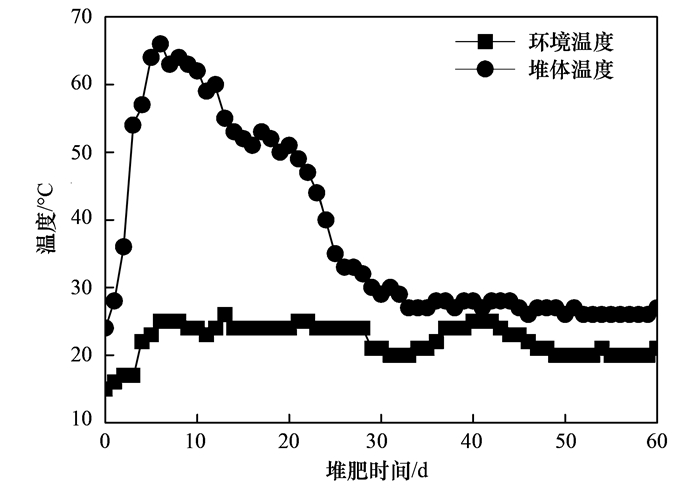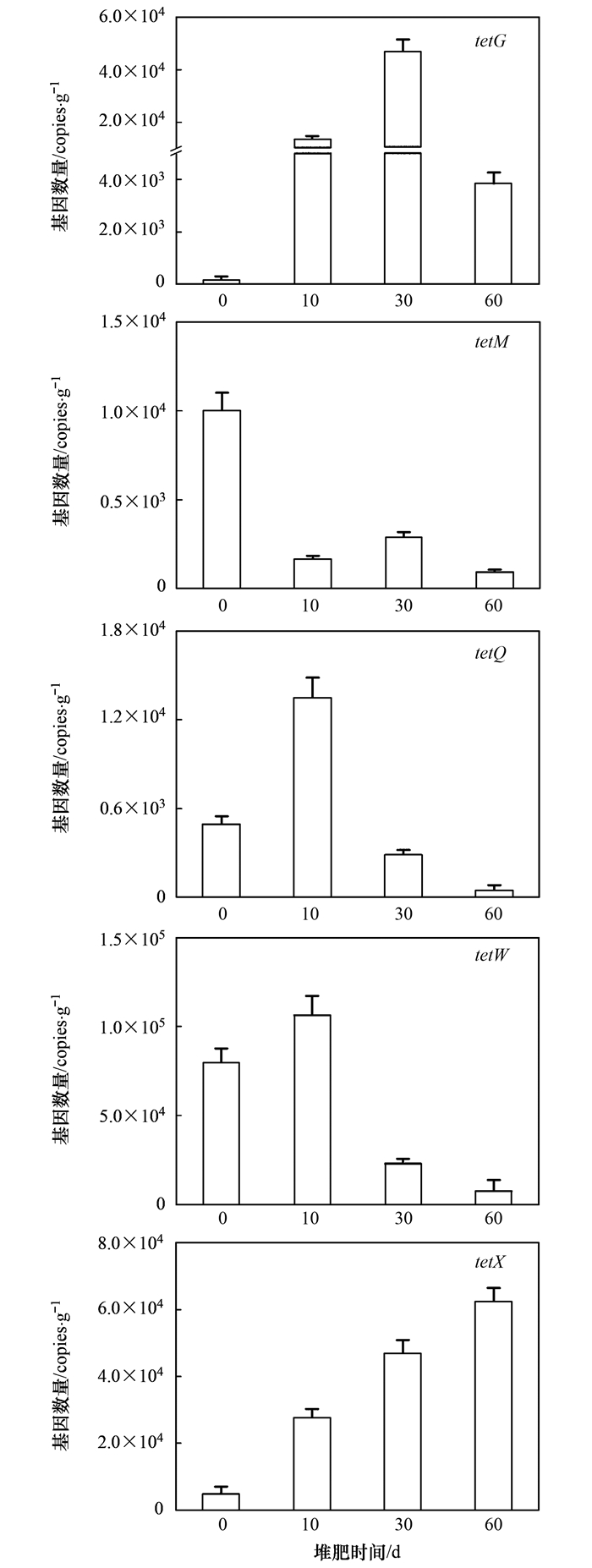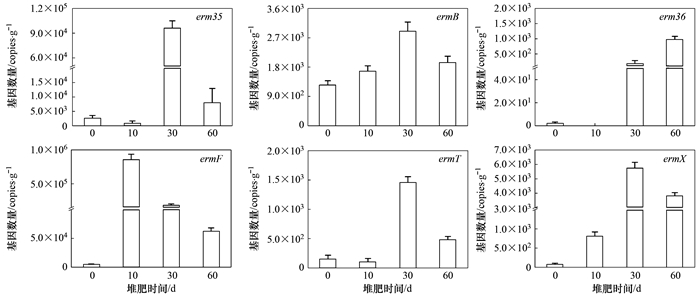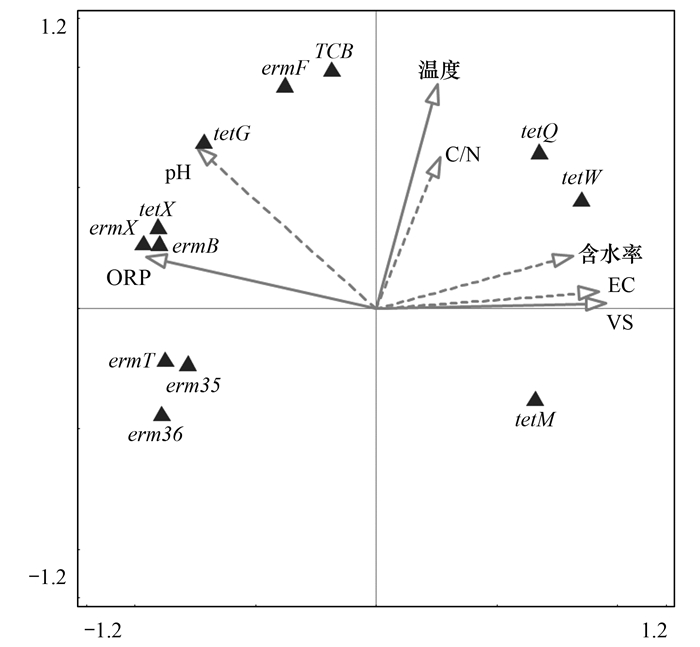2. 哈尔滨工业大学建筑设计研究院, 哈尔滨 150090
2. Architectural Design and Research Institute, Harbin Institute of Technology, Harbin 150090, China
近年来,由于抗生素在养殖业中的广泛使用,导致了大量耐药菌和抗生素抗性基因(antibiotic resistance genes,ARGs)在自然环境中广泛出现.抗生素抗性基因作为一种新型环境污染物,它可通过质粒、可移动遗传元件和整合子等介质进行不同微生物之间的传播和扩散[1, 2],会对人类身体健康产生巨大伤害.目前四环素类和大环内酯类的抗生素被广泛用于畜禽养殖业中,我国畜禽粪便产量巨大,也是环境中这两类抗生素抗性基因的主要来源.如果畜禽粪便处理不当,会直接造成抗生素抗性基因的传播[3~5],在畜禽类粪便及周边废水、沼气残渣、废水处理系统和土壤等样品中均会检测到四环素类和大环内酯类抗性基因[6~8].因此畜禽粪便如何处理受到广泛关注.
高温好氧堆肥可将有机固体废物转化为稳定的有机肥料,可以有效除去粪便中的抗生素和致病微生物,是目前国内外畜禽类粪便处理及资源化的重要途径[9~11].好氧堆肥过程中温度、湿度、有机质和pH等环境因子会显著变化,从而导致微生物种群结构演替[12, 13],这可能会潜在影响畜禽粪便中抗生素抗性基因的丰度和归趋[8, 14].勾长龙等[15]检测猪粪高温堆肥后tetA相对丰度增加,tetG、tetM、tetQ和tetW的相对丰度均下降. Li等[16]检测鸡粪堆肥后tetG、tetW、tetX、ermB、ermF和ermX的相对丰度均降低.但它们在牛粪中的变化情况还不清楚.因此,本研究检测了牛粪好氧堆肥不同阶段典型四环素类抗性基因(tetQ、tetW、tetM、tetG、tetA和tetX)和大环内酯类抗性基因(erm35、erm36、ermB、ermF、ermT、和ermX、)的数量变化规律,探究堆肥过程中温度、含水率、有机质含量(VS)、碳氮比、pH值和ORP变化对两类典型抗性基因分布的影响.堆肥是目前国内外畜禽粪便处理的主要技术,研究堆肥处理过程中环境因子与抗性基因的相关关系对于控制抗生素抗性基因污染具有重要意义.
1 材料与方法新鲜牛粪取自哈尔滨郊区某畜牧场.将新鲜牛粪与木屑(桦树)按2.5 :1(质量比)的比例混合后放于有机玻璃堆反应器中,进行为期60 d的好氧发酵处理.堆肥反应器通风速率为2.5 L ·min-1,每隔10 d对堆肥物料进行翻堆.从反应堆顶部、中部和底部随机采取样品,将其混合成代表性样品.检测60 d堆肥不同时期样品含水率、pH值、氧化还原电位(ORP)、挥发性有机质(VS)含量、碳氮比(C/N)等理化参数的变化规律.
将堆肥样品置于105℃的烘箱中干燥至恒重,根据初始重量和干燥后质量测定牛粪含水率.再将牛粪放于550℃的马弗炉中2 h,残差法测定样品VS含量.将样品研磨并筛选(0.075 mm筛网),用元素分析仪检测总碳、总氮和C/N.将5 g样品加入50 mL ddH2O,振荡2 h后用pH/ORP计测定pH和ORP,每项参数3次重复检测以减少误差.每日利用温度计测量并记录堆肥物料温度和环境温度.
利用MoBio公司的超净土壤DNA提取试剂盒提取样品DNA,按照说明书进行操作. DNA用1%琼脂糖凝胶检测.在ABI 7500 system中对6个四环素类的抗性基因(tetM、tetG、tetQ、tetW、tetA和tetX)、6个大环内酯类抗性基因(erm 35、erm36、ermB、ermF、ermT、和ermX、)和细菌总数进行定量分析,引物序列参照表 1[17, 18]. qPCR反应体系(20 μL):10 μL SYBR® Premix Ex Taq Ⅱ(2×),2 μL DNA模板,0.4 μL ROX Reference Dye Ⅱ(50×),0.8 μL正反向引物(10 μmol ·L-1),6 μL ddH2O.反应条件:95℃ 15 min,95℃ 10 s,退火温度30 s,72℃ 1 min,循环40次.试验数据采用Microsoft Excel和Origin Pro 9.0软件进行整理与分析,并利用CANOCO 5.0软件进行冗余分析,分析堆肥过程中抗性基因与环境因子的相关性.
|
|
表 1 PCR引物序列 Table 1 PCR Primer Sequence |
2 结果与讨论 2.1 堆肥过程中环境因子的变化特征
好氧堆肥不同时期牛粪理化参数变化特征详见表 2.堆肥过程中易降解有机质被微生物逐渐利用[19],牛粪中VS含量由最初83.7%降至堆肥第60 d的63.1%,经过60 d堆肥处理后牛粪中碳含量由36.7%降至22.3%.温度是影响堆肥系统中微生物活性的重要参数(如图 1).堆肥初期有机物分解释放热量导致堆体温度上升,并在堆肥第3 d达到54℃,从而使堆肥系统进入高温阶段.随着牛粪中易降解有机含量逐渐降低,物料温度逐渐下降,并在第30 d左右接近环境温度,这标志着好氧堆肥一次发酵结束腐熟阶段开始.堆肥系统高温和通风条件促进物料中的水分挥发,堆肥处理后牛粪含水率由初始79.7%降至38.2%.
|
|
表 2 牛粪堆肥过程中理化参数的变化 Table 2 Changes in physicochemical parameters during cow manure composting |

|
图 1 堆肥过程中物料温度和环境温度的变化情况 Fig. 1 Changes in material temperature and environmental temperature during cow manure composting |
堆肥初期牛粪中蛋白质水解释放氨氮,牛粪的pH值由6.5上升至第30 d的最大值8.8.有机质的矿化导致C/N由最初14.6上升至第30 d的16.5.高温和水分蒸发造成堆肥中氨气挥发,使堆肥后期牛粪的pH值逐渐降低.堆肥后期温度降低堆体中微生物数量增加,消耗堆体中有机物导致C/N降低.牛粪EC值从20.6 mS ·cm-1降至2.1 mS ·cm-1,这可能是由于牛粪中水溶性化合物含量的减少以及腐殖质的生成[20, 21].除此之外,牛粪ORP值从-109 mV显著上升至162 mV,这可能是由于堆肥过程中微生物对还原性化合物的生物氧化作用[22].
2.2 四环素类抗性基因的变化特征本研究利用qPCR技术检测了堆肥过程中6种典型四环素抗性基因的数量变化情况(见图 2),其中包括3个编码核糖体保护蛋白抗性基因(tetM、tetQ和tetW)、2个编码外排泵蛋白基因(tetA和tetG)和1个酶修饰抗性基因(tetX). tetM含量在新鲜牛粪中最高1.0×104 copies ·g-1,并随着好氧堆肥处理时间逐渐减少.堆肥高温阶段牛粪中tetQ和tetW数量达到最高值,分别为1.4×104和1.1×105 copies ·g-1,这与Su等[23]发现ARGs富集在堆肥嗜热阶段的结果一致. tetQ和tetW数量在腐熟阶段后期下降至4.9×102和7.8×103 copies ·g-1. Guo等[24]也发现猪粪堆肥后ARGs丰度会降低8.1%~96.7%,其中tetW减少90%以上.与之相反,牛粪中tetG含量在堆肥第30 d达到最高4.7×104 copies ·g-1,tetX数量由新鲜牛粪的5.0×103 copies ·g-1逐渐上升至堆肥第60 d的6.3×104 copies ·g-1,而tetA在整个堆肥过程中未检测到.

|
图 2 牛粪堆肥过程中四环素类抗性基因数量的变化 Fig. 2 Quantity changes in tetracycline resistance genes during cow manure composting |
Wang等[25]发现堆肥处理会有效减少污泥中四环素类抗性基因的含量. Yu等[26]也发现在猪粪堆肥中tetM、tetO、tetQ、tetS、tetT、tetW、tetA和tetG的丰度均会有所降低.尽管本研究牛粪堆肥过程中tetM、tetQ和tetW含量同样有所降低,但是与新鲜牛粪相比,堆肥产品中tetG和tetX基因数量是明显增加的,这与Zhang等[27]在污泥堆肥中tetX和tetG拷贝数增加的结果一致.堆肥原料的理化性质、微生物种群结构和堆肥系统环境因子均可能会导致好氧发酵过程中抗性基因变化趋势的差异.
2.3 大环内酯类抗性基因的变化特征牛粪堆肥过程中大环内酯类抗性基因数量变化情况如图 3所示.一次发酵过程中抗性基因ermB、ermX、ermT和erm35含量均显著增加,并在堆肥第30 d达到最高值,分别为2.9×103、5.8×103、1.5×103和9.6×104 copies ·g-1,这一结果与Guo等[24]发现在猪粪堆肥中ermX丰度减少量超过90%明显相反.抗性基因erm36丰度一次发酵过程中数量很低,但是其在腐熟阶段有所升高.另外,牛粪中ermF含量在高温阶段(第10 d)达到最大值(8.6×105 copies ·g-1)后逐渐降低.本研究结果表明堆肥产品中6种大环内酯类抗性基因数量与新鲜牛粪相比均有所增加,可见好氧堆肥并不能去除所有的ARGs,而且导致部分大环内酯类抗性基因含量有所增加.郑宁国[28]发现在猪粪堆肥过程中ermB和ermC丰度降低而ermF丰度增加,相似污泥堆肥过程中ermB丰度降低而ermF丰度增加[29, 30]. Liao等[31]发现在污泥中ermB、ermT和ermX丰度降低而ermF丰度增加.由此可见,牛粪、污泥和猪粪这3种底物在堆肥处理过程中ermB丰度变化特点并不完全相同.

|
图 3 牛粪堆肥过程中大环内酯素类抗性基因数量的变化 Fig. 3 Quantity changes in macrolide resistance genes during cow manure composting |
细菌总数在堆体升温过程中显著升高,堆肥第10 d达到最大值2.2×108 copies ·g-1,在此之后堆肥样品中细菌总数开始逐渐降低[图 4(a)].由于堆肥系统中抗性基因数量与细菌数量密切相关,本研究分别考察了堆肥过程中上述6种四环素类抗性基因和6种大环内酯类抗性基因与细菌总数相对丰度的变化规律[图 4(b)和4(c)].在笔者检测的6种典型四环素类抗性基因中,新鲜牛粪中tetM和tetW相对丰度最高而tetG丰度最低.尽管堆肥第10 d tetQ、tetW、tetG和tetX数量有所上升,但是全部6种四环素类抗性基因的相对丰度均有所下降,一方面堆肥高温环境对部分嗜温细菌具有较强的抑制作用,另一方面这些抗性基因可能具有相同的宿主细胞或是它们的宿主细胞间存在正相关[32, 33].经过60 d堆肥处理后tetX相对丰度明显高于其它5种四环素类抗性基因,成为牛粪堆肥产品中最主要的四环素类抗性基因.对比数据发现牛粪堆肥中tetM、tetQ和tetW减少幅度大于tetG. Peng等[34]发现鸡粪堆肥过程中tetM减少幅度大于tetG. Yu等[26]发现猪粪堆肥过程中tetM、tetQ和tetW均减少,而tetG没有明显变化.编码核糖体保护蛋白基因(tetM、tetQ和tetW)的主要是革兰氏阳性菌,而编码外排泵蛋白基因(tetA和tetG)的主要是革兰氏阴性菌,革兰氏阳性菌比革兰氏阴性菌更容易去除,致使堆肥处理后tetM、tetQ和tetW减少幅度大于tetG[7, 34, 35].

|
(a)细菌数量;(b)四环素类抗性基因相对丰度;(c)大环内酯类抗性基因相对丰度 图 4 堆肥过程中细菌数量与抗性基因相对丰度的变化规律 Fig. 4 Relationship between resistance genes and bacterial quantities during cow manure composting |
与四环素类抗性基因的变化规律相似,牛粪堆肥中erm35、erm36、ermT、ermB和ermX这5种大环内酯类抗性基因的相对丰度也在高温阶段达到最低,分别为3.9×10-6、0、4.8×10-7、7.6×10-6和3.8×10-6.这一研究结果表明尽管高温阶段抗性基因数量与细菌总数呈正相关,但这一时期大部分抗性基因的相对丰度却明显降低.另外,整个堆肥过程中ermF的相对丰度明显高于其它5种大环内酯类抗性基因. ermF的相对丰度在高温阶段最高(3.9×10-3)且随后变化不显著,成为牛粪堆肥产品中最主要的大环内酯类抗性基因.韦蓓等[29]发现在污泥堆肥中ermB和ermF相对丰度在高温阶段降低而ermF相对丰度在冷却和腐熟阶段有所升高. Liao等[31]发现在污泥堆肥中ermT、ermB和ermX在高温阶段降低而ermF相对丰度在冷却和腐熟阶段升高,本实验结果与其一致.
2.5 堆肥系统抗性基因与环境因子的相关性本研究采用冗余分析法(RDA)评价堆肥系统温度、含水率、VS、C/N、pH和ORP等环境因子以及细菌总数与上述12种典型抗生素抗性基因数量的相关关系(如图 5).研究数据表明牛粪堆肥过程中对抗性基因分布规律影响最重要的3个环境因子分别为ORP(54.8%)、温度(34%)和VS(11.3%).抗性基因tetW和tetM的丰度与挥发性有机质含量呈正相关,其中对tetW的影响最大.抗性基因(tetX、ermX和ermB)的丰度与ORP呈正相关,但对ermX和ermB丰度影响程度最大. Wang等[13]发现在污泥堆肥过程中微生物群落受ORP、温度和含水率影响较大,而堆肥中微生物结构的变化会显著影响ARGs分布.抗性基因tetQ和ermF的丰度和细菌总数与温度呈正相关且有相同的变化趋势,其中温度对细菌总数影响程度最大. Li等[16]发现添加竹炭的鸡粪堆肥过程中ARGs受到温度、C/N和pH的影响较大. Zhang等[36]发现不同表面活性剂处理鸡粪堆肥过程中ARGs受到温度、pH和水溶性碳的影响较大.堆肥过程中温度是影响微生物活性和分布的重要参数[37, 38],是破坏和灭活耐药细菌和ARGs的关键变量[36].

|
实虚箭头线:抗性基因分布变异影响是否重要的环境因子,实线:重要因子,虚线:次要因子,三角形:抗性基因 图 5 抗性基因与环境因子的关系 Fig. 5 Relationship between resistance genes and environmental factors |
牛粪堆肥过程中tetM、tetQ和tetW数量显著减少,tetG和tetX含量有所升高,而且与新鲜牛粪相比,经过60 d堆肥处理后6种大环内酯类抗性基因数量均有所增加.在笔者检测的12种典型抗生素抗性基因中,牛粪堆肥产品中tetX和ermF含量最高.好氧堆肥高温阶段牛粪中tetM、tetQ、tetW、tetX、erm35、erm36、ermB、ermT、和ermX的相对丰度显著降低.冗余分析表明温度、ORP和VS分别是影响牛粪堆肥系统中ermF、tetQ、ermX、ermB和tetW含量的主要环境因子.
致谢: 感谢哈尔滨工业大学城市水资源与水环境国家重点实验室.| [1] |
苏建强, 黄福义, 朱永官. 环境抗生素抗性基因研究进展[J]. 生物多样性, 2013, 21(4): 481-487. Su J Q, Huang F Y, Zhu Y G. Antibiotic resistance genes in the environment[J]. Biodiversity Science, 2013, 21(4): 481-487. |
| [2] | Wu D, Huang X H, Sun J Z, et al. Antibiotic resistance genes and associated microbial community conditions in aging landfill systems[J]. Environmental Science & Technology, 2017, 51(21): 12859-12867. |
| [3] | Jechalke S, Heuer H, Siemens J, et al. Fate and effects of veterinary antibiotics in soil[J]. Trends in Microbiology, 2014, 22(9): 536-545. DOI:10.1016/j.tim.2014.05.005 |
| [4] | Kong W D, Zhu Y G, Fu B J, et al. The veterinary antibiotic oxytetracycline and Cu influence functional diversity of the soil microbial community[J]. Environmental Pollution, 2006, 143(1): 129-137. DOI:10.1016/j.envpol.2005.11.003 |
| [5] | Lin H, Zhang J, Chen H J, et al. Effect of temperature on sulfonamide antibiotics degradation, and on antibiotic resistance determinants and hosts in animal manures[J]. Science of the Total Environment, 2017, 607-608: 725-732. DOI:10.1016/j.scitotenv.2017.07.057 |
| [6] | Cheng W X, Li J N, Wu Y, et al. Behavior of antibiotics and antibiotic resistance genes in eco-agricultural system:a case study[J]. Journal of Hazardous Materials, 2016, 304: 18-25. DOI:10.1016/j.jhazmat.2015.10.037 |
| [7] | Liu M M, Zhang Y, Yang M, et al. Abundance and distribution of tetracycline resistance genes and mobile elements in an oxytetracycline production wastewater treatment system[J]. Environmental Science & Technology, 2012, 46(14): 7551-7557. |
| [8] | Marti E, Jofre J, Balcazar J L. Prevalence of antibiotic resistance genes and bacterial community composition in a river influenced by a wastewater treatment plant[J]. PLoS One, 2013, 8(10): e78906. DOI:10.1371/journal.pone.0078906 |
| [9] |
何芳, 罗阳, 浣成, 等. 高温堆肥技术在我国畜禽粪便污染治理中的应用[J]. 安徽农业科学, 2018, 46(17): 41-43. He F, Luo Y, Huan C, et al. Application of high-temperature composting technology in the pollution treatment of livestock and poultry manure in China[J]. Journal of Anhui Agricultural Sciences, 2018, 46(17): 41-43. DOI:10.3969/j.issn.0517-6611.2018.17.012 |
| [10] | Ho Y B, Zakaria M P, Latif P A, et al. Degradation of veterinary antibiotics and hormone during broiler manure composting[J]. Bioresource Technology, 2013, 131: 476-484. DOI:10.1016/j.biortech.2012.12.194 |
| [11] | Wang J, Ben W W, Zhang Y, et al. Effects of thermophilic composting on oxytetracycline, sulfamethazine, and their corresponding resistance genes in swine manure[J]. Environmental Science:Processes & Impacts, 2015, 17(9): 1654-1660. |
| [12] | Wang K, Chu C, Li X K, et al. Succession of bacterial community function in cow manure composing[J]. Bioresource Technology, 2018, 267: 63-70. DOI:10.1016/j.biortech.2018.06.028 |
| [13] | Wang K, Mao H L, Li X K. Functional characteristics and influence factors of microbial community in sewage sludge composting with inorganic bulking agent[J]. Bioresource Technology, 2018, 249: 527-535. DOI:10.1016/j.biortech.2017.10.034 |
| [14] |
王伟东, 王小芬, 朴哲, 等. 堆肥化过程中微生物群落的动态[J]. 环境科学, 2007, 28(11): 2591-2597. Wang W D, Wang X F, Piao Z, et al. Microbial dynamics during the composting process[J]. Environmental Science, 2007, 28(11): 2591-2597. DOI:10.3321/j.issn:0250-3301.2007.11.032 |
| [15] |
勾长龙, 王雨琼, 张喜庆, 等. 高温堆肥对猪粪中四环素类抗生素及抗性基因的影响[J]. 环境科学学报, 2017, 37(4): 1454-1460. Gou C L, Wang Y Q, Zhang X Q, et al. Effects of high-temperature composting on tetracyclines and tetracycline resistance genes in swine manure[J]. Acta Scientiae Circumstantiae, 2017, 37(4): 1454-1460. |
| [16] | Li H C, Duan M L, Gu J, et al. Effects of bamboo charcoal on antibiotic resistance genes during chicken manure composting[J]. Ecotoxicology and Environmental Safety, 2017, 140: 1-6. DOI:10.1016/j.ecoenv.2017.01.007 |
| [17] | Chen J, Yu Z T, Michel F C Jr, et al. Development and application of real-time PCR assays for quantification of erm genes conferring resistance to macrolides-lincosamides-streptogramin b in livestock manure and manure management systems[J]. Applied and Environmental Microbiology, 2007, 73(14): 4407-4416. DOI:10.1128/AEM.02799-06 |
| [18] |
钱勋.好氧堆肥对畜禽粪便中抗生素抗性基因的削减条件探索及影响机理研究[D].杨凌: 西北农林科技大学, 2016. 1-140. Qian X. Mechanism and conditions for reducing antibiotic resistance genes during aerobic composting of livestock manure[D]. Yangling: Northwest A & F University, 2016. 1-140. http://cdmd.cnki.com.cn/Article/CDMD-10712-1017003402.htm |
| [19] |
康军.杨凌城市污泥高效好氧堆肥研究[D].杨凌: 西北农林科技大学, 2012. Kang J. High-efficiency aerobic composting of municipal sewage sludge in Yangling[D]. Yangling: Northwest A & F University, 2012. http://cdmd.cnki.com.cn/Article/CDMD-10712-1012437405.htm |
| [20] |
郑宁国.猪粪堆肥对抗生素抗性基因的影响及微生物群落变化的初步探究[D].西安: 西北大学, 2016. Zheng N G. Effects of swine manure composting on ARGs and the initial research of changes of microorganism community[D]. Xi'an: Northwest University, 2016. http://cdmd.cnki.com.cn/Article/CDMD-10697-1017027165.htm |
| [21] | Gao M C, Liang F Y, Yu A, et al. Evaluation of stability and maturity during forced-aeration composting of chicken manure and sawdust at different C/N ratios[J]. Chemosphere, 2010, 78(5): 614-619. DOI:10.1016/j.chemosphere.2009.10.056 |
| [22] | Liu C G, Xue C, Lin Y H, et al. Redox potential control and applications in microaerobic and anaerobic fermentations[J]. Biotechnology Advances, 2013, 31(2): 257-265. |
| [23] | Su J Q, Wei B, Ou-Yang W Y, et al. Antibiotic resistome and its association with bacterial communities during sewage sludge composting[J]. Environmental Science & Technology, 2015, 49(12): 7356-7363. |
| [24] | Guo A Y, Gu J, Wang X J, et al. Effects of superabsorbent polymers on the abundances of antibiotic resistance genes, mobile genetic elements, and the bacterial community during swine manure composting[J]. Bioresource Technology, 2017, 244: 658-663. |
| [25] | Wang R, Zhang J Y, Sui Q W, et al. Effect of red mud addition on tetracycline and copper resistance genes and microbial community during the full scale swine manure composting[J]. Bioresource Technology, 2016, 216: 1049-1057. DOI:10.1016/j.biortech.2016.06.012 |
| [26] | Yu Z T, Michel F C Jr, Hansen G, et al. Development and application of real-time PCR assays for quantification of genes encoding tetracycline resistance[J]. Applied and Environmental Microbiology, 2005, 71(11): 6926-6933. DOI:10.1128/AEM.71.11.6926-6933.2005 |
| [27] | Zhang J Y, Sui Q W, Tong J, et al. Soil types influence the fate of antibiotic-resistant bacteria and antibiotic resistance genes following the land application of sludge composts[J]. Environment International, 2018, 118: 34-43. DOI:10.1016/j.envint.2018.05.029 |
| [28] |
郑宁国, 黄南, 王卫卫, 等. 高温堆肥过程对猪粪来源抗生素抗性基因的影响[J]. 环境科学, 2016, 37(5): 1986-1992. Zheng N G, Huang N, Wang W W, et al. Effects of thermophilic composting on antibiotic resistance genes (ARGs) of swine manure source[J]. Environmental Science, 2016, 37(5): 1986-1992. |
| [29] |
韦蓓, 黄福义, 李虎, 等. 污泥堆肥过程中磺胺类和大环内酯类抗性基因的残留[J]. 应用与环境生物学报, 2014, 20(3): 395-400. Wei P, Huang F Y, Li H, et al. Persistence of sulfonamide and macrolide resistance genes during sewage sludge composting[J]. Chinese Journal of Applied and Environmental Biology, 2014, 20(3): 395-400. |
| [30] | Zhang J Y, Chen M X, Sui Q W, et al. Impacts of addition of natural zeolite or a nitrification inhibitor on antibiotic resistance genes during sludge composting[J]. Water Research, 2016, 91: 339-349. DOI:10.1016/j.watres.2016.01.010 |
| [31] | Liao H P, Lu X M, Rensing C, et al. Hyperthermophilic composting accelerates the removal of antibiotic resistance genes and mobile genetic elements in sewage sludge[J]. Environmental Science & Technology, 2018, 52(1): 266-276. |
| [32] | Wu D, Huang Z T, Yang K, et al. Relationships between antibiotics and antibiotic resistance gene levels in municipal solid waste leachates in shanghai, China[J]. Environmental Science & Technology, 2015, 49(7): 4122-4128. |
| [33] | Qian X, Sun W, Gu J, et al. Variable effects of oxytetracycline on antibiotic resistance gene abundance and the bacterial community during aerobic composting of cow manure[J]. Journal of Hazardous Materials, 2016, 315: 61-69. DOI:10.1016/j.jhazmat.2016.05.002 |
| [34] | Peng S, Li H J, Song D, et al. Influence of zeolite and superphosphate as additives on antibiotic resistance genes and bacterial communities during factory-scale chicken manure composting[J]. Bioresource Technology, 2018, 263: 393-401. DOI:10.1016/j.biortech.2018.04.107 |
| [35] | Chopra I, Roberts M. Tetracycline antibiotics:mode of action, applications, molecular biology, and epidemiology of bacterial resistance[J]. Microbiology and Molecular Biology Reviews, 2001, 65(2): 232-260. DOI:10.1128/MMBR.65.2.232-260.2001 |
| [36] | Zhang Y J, Li H C, Gu J, et al. Effects of adding different surfactants on antibiotic resistance genes and intI 1 during chicken manure composting[J]. Bioresource Technology, 2016, 219: 545-551. DOI:10.1016/j.biortech.2016.06.117 |
| [37] | Zhang R R, Gu J, Wang X J, et al. Contributions of the microbial community and environmental variables to antibiotic resistance genes during co-composting with swine manure and cotton stalks[J]. Journal of Hazardous Materials, 2018, 358: 82-91. |
| [38] | Dobal-Amador V, Nieto-Cid M, Guerrero-Feijóo E, et al. Vertical stratification of bacterial communities driven by multiple environmental factors in the waters (0-5000 m) off the Galician coast (NW Iberian margin)[J]. Deep Sea Research Part I:Oceanographic Research Papers, 2016, 114: 1-11. |
 2019, Vol. 40
2019, Vol. 40


